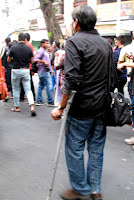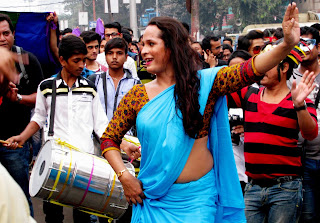Insight, Clickhappy! Dec '15
By Prosenjit Pal and Pawan Dhall
The ‘14th Kolkata Rainbow Pride Walk’ on December 13, 2015 was many things for many people – an expression of not just queer pride but also solidarity with diverse social causes. Demanding intolerance for social exclusion of any kind, it broke new ground with participation by many youth and student groups and a ‘Hok Chumban’ / ‘Kiss of Love’ campaign at the end to protest moral policing anywhere and everywhere. While the walk route took Pawan Dhall down memory lane to 1999 (the year of the ‘1st Kolkata Rainbow Pride Walk’), Prosenjit Pal celebrated his very first queer pride walk in his home town with camera in hand.
By Prosenjit Pal and Pawan Dhall
 |
| Photo credits: Prosenjit Pal, unless mentioned otherwise |
The ‘14th Kolkata Rainbow Pride Walk’ on December 13, 2015 was many things for many people – an expression of not just queer pride but also solidarity with diverse social causes. Demanding intolerance for social exclusion of any kind, it broke new ground with participation by many youth and student groups and a ‘Hok Chumban’ / ‘Kiss of Love’ campaign at the end to protest moral policing anywhere and everywhere. While the walk route took Pawan Dhall down memory lane to 1999 (the year of the ‘1st Kolkata Rainbow Pride Walk’), Prosenjit Pal celebrated his very first queer pride walk in his home town with camera in hand.
 |
| Photo credit: Pawan Dhall |
The
starting point was outside Deshbandhu Park near Shyambazar five-point crossing
in North Kolkata. While the park itself was taken over by a political party
function, the walk participants gathered quietly outside. But the celebratory
roar with which the walkers started off at 2.30 pm couldn’t have been captured
by a photographic camera!
Youth
(including college and university students) and women’s participation was a
standout feature of this year’s walk – an important mobilization milestone in
the 14-year history of the walk.
The Kolkata walk, at least sections of it, joined its
counterparts in Hyderabad, Bangalore, Delhi and elsewhere in recognizing and
highlighting intersections between the human rights struggles of queer
communities and other marginalized sections of society. Cries of “Lesbian mange
aazadi . . . Irom [Chanu Sharmila] mange aazadi . . . Kashmir mange aazadi . .
.” rent the air. But more introspection on how the queer movements can join
hands with these and issues of class may be a good idea.
 |
| Photo credit: Pawan Dhall |
For starters, how about involving the street children in a
more respectful and fun manner in the walk? They are possibly the only ones who
‘participate’ every year out of sheer childlike excitement and without being
mobilized! Not to forget the young drummers who are as much part of India’s ‘demographic
dividend’ as the students who came from Jadavpur University, Indian Institute of Technology, Kharagpur or West Bengal University of Juridical Sciences. Similarly,
encouraging more people, young and old, from the smaller cities and villages of
West Bengal and other states to participate remains a challenge.
At
the start, the walk strength was a couple of hundreds. But as it wound its way
through Acharya Prafulla Chandra Road and reached the end point at Moulali
Ramlila Maidan, the numbers swelled to around 1,500 – a sea of humanity full of
colour, energy and hope in defiance of socio-legal stigma, discrimination and
criminalization.
Author
Pawan Dhall exults as the walk passes by George Bhawan on Creek Lane – the circled
red building – venue of the media interaction after the ‘1st Kolkata Rainbow Pride Walk’ (officially called ‘Friendship Walk’) on July 2, 1999. For many
years from 1997, George Bhawan was also where Counsel Club, eastern India’s
first queer support group, met for its fortnightly / monthly meetings.
Shoot fest or photo orgy!
The
masks were there, but on a hunch, far fewer than in the past walks, while family
members, friends and colleagues of queer individuals seemed to have become a
regular feature of the walk.
Among
the many inspiring speeches made during the public meeting at the end point (Moulali
Ramlila Maidan) were those of queer activist Sayak Manna (extreme left) who spoke about building
bridges across different sections of society; disability and gender rights
activist Shampa Sengupta (centre), who was thrilled to be back at her childhood
playground and called for an in-depth dialogue between social movements; and
mathematics professor Pratulananda Das, who urged queer teachers to think about
coming out to help themselves and their students.
Around
two dozen couples, threesomes and foursomes – across genders and sexualities –
kissed friends and loved ones in varying degrees of passion as a symbol of
protest (an extension of the ‘Kiss of Love’ campaign) against moral policing
that affects anyone who steps beyond supposed norms of culture and decency in
matters ranging from choice of clothes and public display of affection to
gender and sexual expression, relationships, family structures and even
literary and artistic works.
 |
| Photo credit: Pawan Dhall |
A
round of foot-tapping musical numbers brought the curtains down on a
well-organized event by 6 pm. The move to shift the walk from the traditional
months of June / July to December seemed to have paid off in terms of the
number of participants. All in all, a job well done by the organizers, whether
individual volunteers or those from various community groups and NGOs, who
ensured everything from police permissions, decorations and music to drinking
water and crowd management during the walk.














Great post! Wish I had been there.
ReplyDeleteAs discussion, research and documentation related to the Indian queer movement grows, hitherto unknown aspects are emerging. According to some sources of information, the 'Kolkata Rainbow Pride Walk' organized on July 2, 1999 may not be the first ever queer pride event in the city, India or South Asia. It may well have been preceded by other similar events in Kolkata or elsewhere. We will share information on this as and when more is known in this regard - Editor.
ReplyDelete